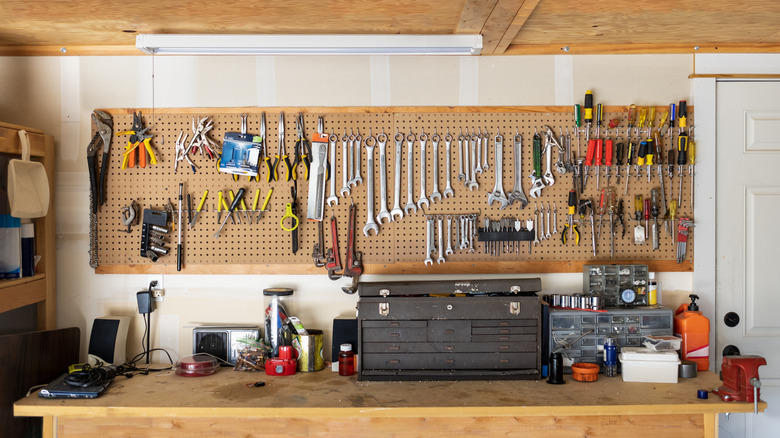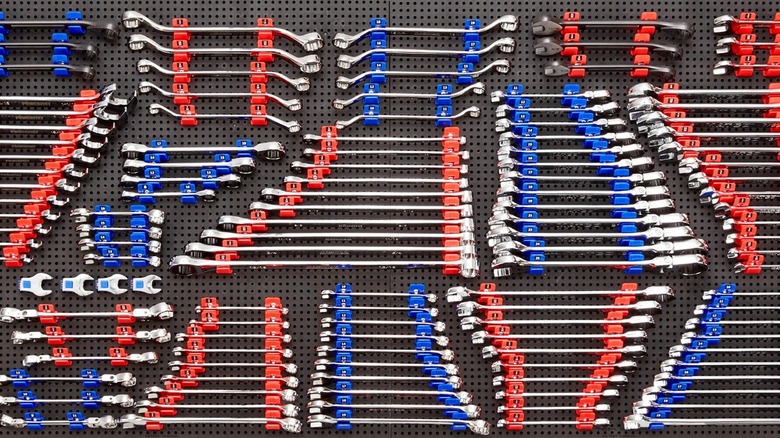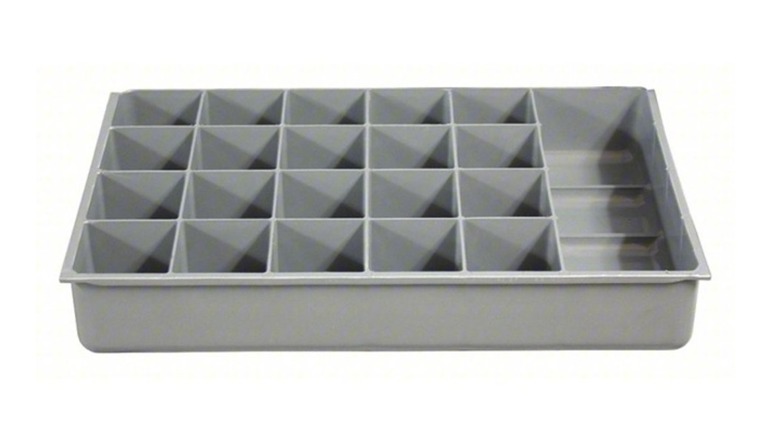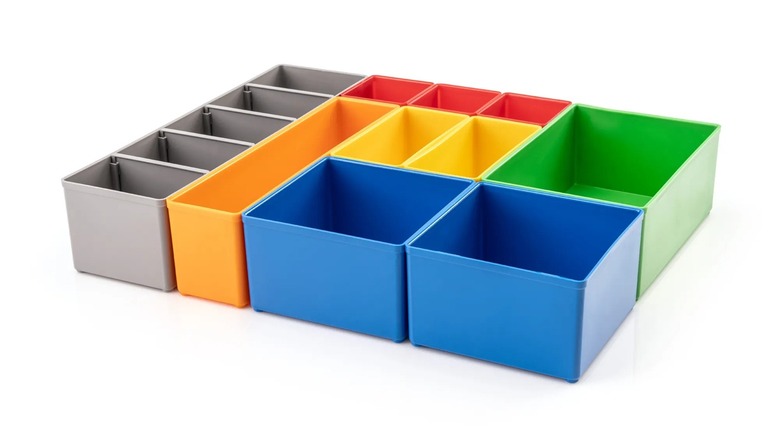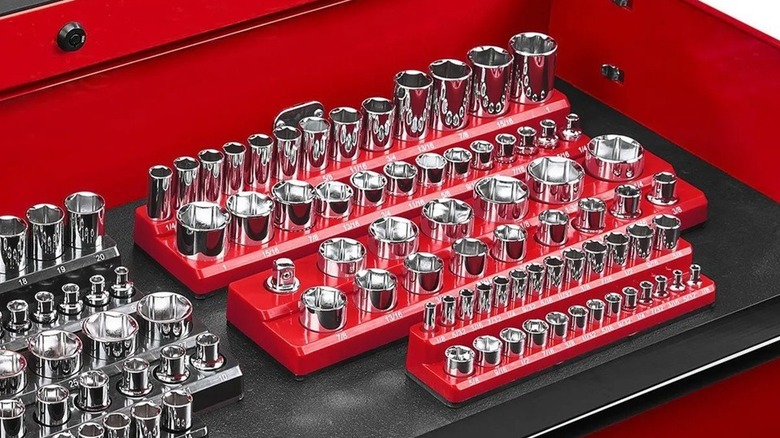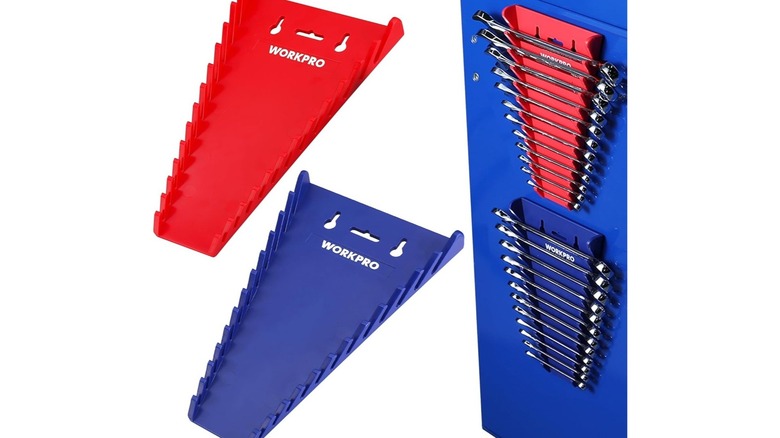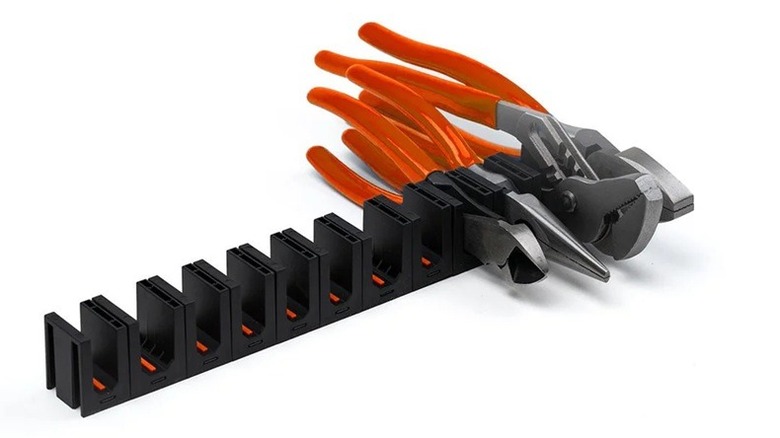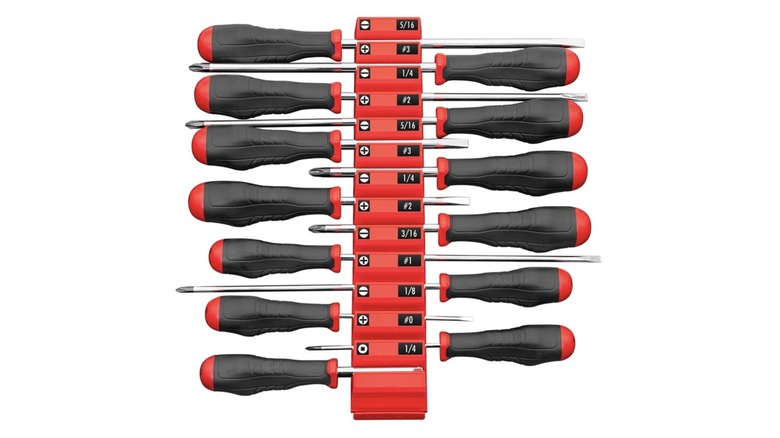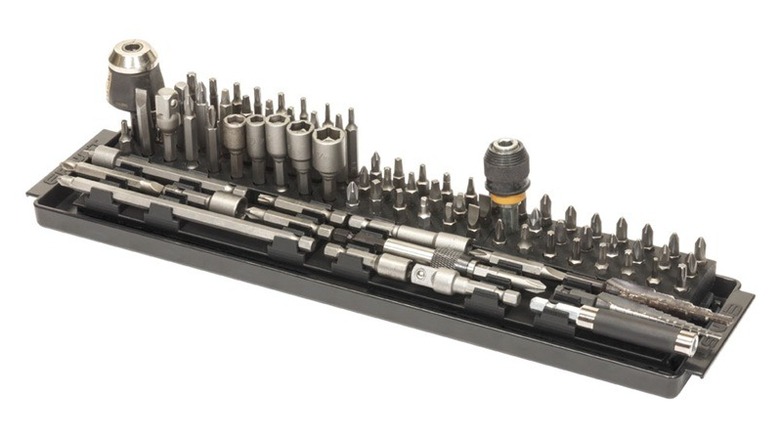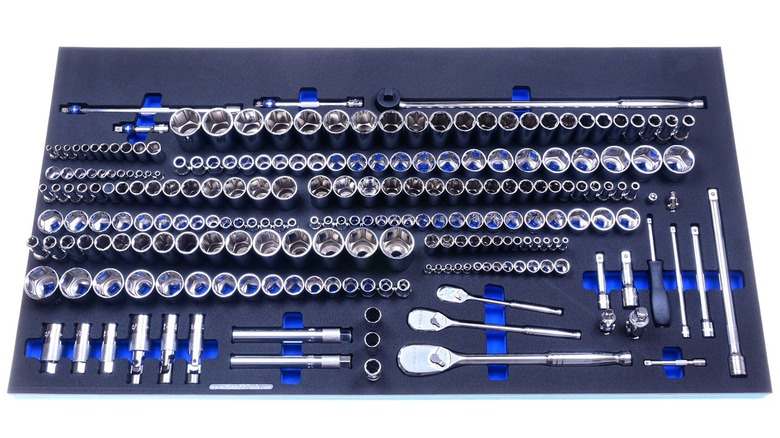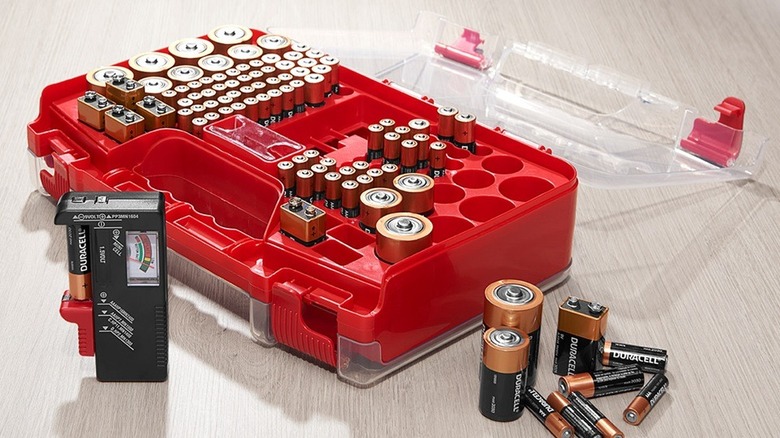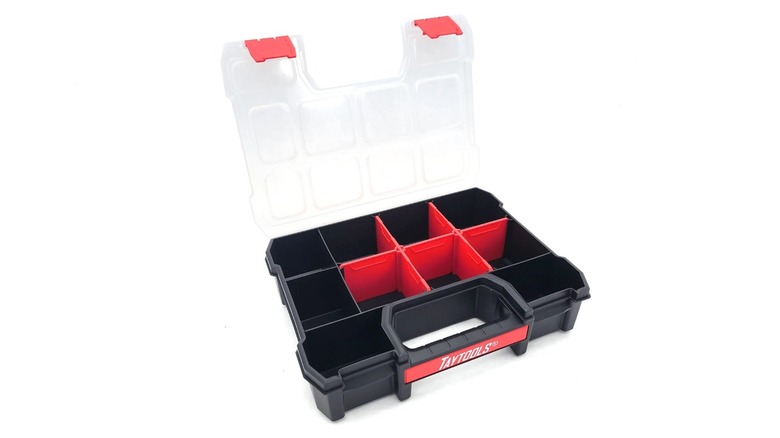11 Tool Box Organizers To Manage Your Mess
We may receive a commission on purchases made from links.
The ideal tool shop is one where you always have the tools you need. Of course, having the right tool for the job is one thing; being able to find it is another. It's not hard to hoard one tool or so too many, and the more expansive your tool collection, the more effective it can be. But this only true if you know where things are when you need them.
Even the best toolboxes are famous for high entropy. The constant opening and closing of drawers and shuffling around looking for things means that tools get mixed up and lost all the time. Things are even worse if you take your toolbox on the go, moving it from a workshop to remote job sites and back again. It never seems like you can find that tool when it's the only right one for the job.
If you want to keep your tools straight, the only real solution is to find the right organizational strategy. There are lots of toolbox organization options on the market, each one designed to help you keep your tools where they belong. In the same way that every job needs the right tool, every tool needs the right organization solution. These are 11 of our favorites.
Toolgrid
The Toolgrid organization system is modular and fully customizable, allowing you to create whatever organization and storage solution works best for you. Toolgrid begins with a pegboard featuring thousands of tiny holes. Then you can select from an array of tool holders, each with pins made to fit into the pegboard holes.
Because there are so many pin holes and so many different tool holders, you can create a customized layout in your toolbox drawers for whatever tools you have. There are no wrong answers with Toolgrid as you can organize tools however you prefer: by tool type, by job type, by frequency of use, or however you prefer. And you don't have to commit. You have the flexibility to rearrange your setup over time as you gain new tools or want to try new layouts.
Setting up your Toolgrid system is relatively simple but time-consuming. You start by trimming the provided pegboard to fit inside the drawer of your toolbox. Then you insert the desired tool holders into the pegboard and lock them in place with screws. You can then label the tool holders if you want, to make locating your tools even easier. It's one of the pricier tool organization options on the market, but you can't beat Toolgrid for its versatility.
Compartment organizer
Sometimes, all you need are some dividers to keep things separated and prevent them from mixing together in the drawers. Compartment organizers are premade trays, usually made of hard plastic or metal, featuring several distinct compartments. They come in different styles, usually with a few compartments of varying sizes to accommodate different tools.
It's not a perfect organizational solution, but with compartments, you can search from a much smaller space and know roughly where things are going to be, even if it's been a while since your last job. Premade compartment organizers are one of the more straightforward types of organizers, but they get the job done.
They are designed to fit inside the shelves of a standard toolbox, and you can use them to separate and store a range of tools. Depending on the size of your toolbox and the compartment organizers you choose, you can combine multiple trays to create a slightly customized layout. Some even come with lids and locks, so you can tuck away any tools you want to keep all to yourself.
Organizer bin set
Bin organizer sets are similar to the previously mentioned compartment organizers, with one important difference. They are way more customizable. Instead of a static premade tray, you get an assortment of differently sized bins which you can organize and rearrange any which way to create the right organization system for you.
Where compartment organizer trays are already frozen in a permanent configuration, each of the bins in a bin organizer set stands alone and can be moved freely like Tetris blocks, into any layout you can imagine. Bins of different sizes and shapes are also available in different colors, improving their organization potential. You could, for instance, keep all of the screws in the blue bins, all of the nails in the yellow bins, and all of the washers in the orange bins. Creating a color-coded shorthand can save you time on the job.
Because the bins are all small and individual, they can fit a wider variety of toolboxes. If one set isn't enough, you can get another or purchase individual bins to fill out your toolbox landscape. And while you're on the job, you can pull out individual boxes to get at the tools you need, while leaving everything else safe and secure in the toolbox.
Socket organizer
Bolts (and nuts) are used in a wide range of constructions because of their stability and build security. They usually feature thick posts with heavy threads for a secure connection, and the geometric shape of the head provides multiple contact points for a socket wrench, improving torque. Bolts are one of the most user-friendly fasteners in existence, but good luck moving one without the right socket for your wrench.
Finding the right socket wrench set for your needs is one of the most important questions for any new tool set, but once you've found it, you're going to need a way to store and organize those sockets. Socket wrenches are incredibly useful — and one of the most common tools on any job site — but the small size of the sockets makes them easy to lose, and the similarity of size and design among different sockets makes them easy to mix up. Worst of all, the most commonly used sockets are usually the ones that get lost first. Just try finding a 10-millimeter socket wrench anywhere.
A socket organizer tray can keep your sockets right where you need them, when you need them. Some of them even feature magnetic bases, allowing you to attach them to any ferrous metal surface, including the top or side of your toolbox.
Magnetic wrench rack
Wrench racks are pretty straightforward. They keep your wrenches laid out in a line, and in order from largest to smallest. They typically feature angled slots for each wrench, allowing them to slot into place whether the rack is laid down horizontally inside a toolbox shelf or mounted vertically. Magnets on the back/bottom of the rack allow you to attach the rack to the side of your toolbox or to any other ferrous metal surface.
These wrench racks from WORKPRO are made of hard plastic and feature a set of pre-drilled holes so you can mount them to non-metal surfaces, if you decide to hang them somewhere other than your toolbox. Each rack holds up to 12 wrenches and comes as a set of two, accommodating a total of 24 wrenches while keeping them organized.
Each rack is about 10 inches long and narrower on one end, 2.4 inches on one side, and 6.1 inches on the other. The shape allows two of them to sit nicely inside a toolbox shelf when laid down in opposite directions, and they can hold wrenches of varying lengths. Each one can accommodate SAE (Society of Automotive Engineers) or imperial unit wrenches from 1/4-inch to 15/16 and metric wrenches from 6 to 24 millimeters.
Modular pliers rack
Whether you've got one set of pliers or several dozen, a modular solution lets you create a pliers rack that's just right for you. This set from Toolbox Widget comes with 12 modules, holding up to 12 pliers, but you can add additional modules to accommodate as many as you like. The kit comes with ten 13mm modules and two 18mm modules to fit slimmer and wider-handled pliers.
Each module slots together easily, locking into place in your toolbox with strong neodymium magnets. They are strong enough to work through thin drawer liners and keep your pliers in place even as drawers open and close or while transporting your tools. You can use a single module to hold most tools, but heavier ones may require two widgets, with one placed at either end. That may also be preferable if you take your toolbox on the road and want a firmer grasp between jobs.
Each module is about 1.5 inches tall and just over an inch wide, fitting neatly inside most toolbox drawers. They are made out of a combination of plastic and rubber, which makes them rigid enough to keep a firm hold but flexible enough to bend and release your tools without breaking. And an orange line down the middle makes it obvious when a tool is removed, so you can tell at a glance if everything is in its correct place.
Screwdriver gripper rack
Screwdrivers are one of the most commonly used tools in workshops and around the house. The more a tool gets used, the more likely it is to get lost or misplaced. A screwdriver gripper rack, like the Screwdriver Pro from Ernst, gives every screwdriver a home and can prevent lost tools long-term.
By pressing the neck of a screwdriver into one of the rack's slots, pressure holds it securely in place, but it's flexible enough to release the driver when you want it. Like other tool organizers, this gripper rack has a modular design, allowing you to add or remove modules and create a working storage system, no matter how many screwdrivers you have in your collection. Modules come in single blocks and triple-slot blocks.
Nonslip cleats on the bottom of the modules sink into your toolbox's drawer liner and prevent them from moving around when you open and close the drawers. An optional magnetic base provides an even more secure attachment. The kit also includes identification labels for driver type and size, so you can find your standard, Phillips, hex drivers, and more at a glance.
Magnetic bit organizer
There are few tools easier to lose than drill bits and driver bits. They are tiny, and they all look similar, so that even if you have all of them in a toolbox drawer, you might waste valuable time sorting through them for the one you need. Worse, they're small enough to disappear into a corner or beneath a drawer liner, never to be seen again.
The Bit Boss from Ernst holds up to 90 bits. They'll stay in place securely, and you'll be able to see everything neatly, so you can get the bit you need quickly. The Bit Boss holds a variety of bits with shorter bits standing vertically in the shallow holes on one side, while mid-sized and long bits lie horizontally on the other side. Each channel is tapered at the bottom, providing a pressure lock when you press bits into place while releasing them easily with minimal force.
It's designed to fit in most standard toolbox shelves, sitting 14.9 inches long, 3.6 inches wide, and just 1.2 inches tall. Even with the short bits standing vertically in their slots, the Bit Boss fits snugly inside a closed toolbox drawer. Magnets on the underside of the Bit Boss let you attach the organizer securely to the inside of your toolbox or vertically on the outside.
Foam insert organizer
While there are plenty of one-size-fits-all, universal toolbox storage solutions on the market, you might be able to get something custom-made. Depending on the tools you have, you may be able to find a specially designed foam insert, specifically made for holding your tools. Foam Fit Tools offers a wide range of foam organizer inserts compatible with common tool sets. With multiple inserts, slotted into multiple drawers, you could feasibly organize your entire tool collection.
The 90 Tekton Inch Sockets foam insert organizer is designed for use with the 214-piece Tekton tool set. It holds various sockets in custom-made slots, with size identifiers laser-engraved into the foam. The insert doesn't accommodate the entire Tekton set, just the inch sockets, and it's designed to fit inside the top drawer of a standard 52-inch or 56-inch toolbox, with some wiggle room leftover for other tools. That's just one example.
You can get a different liner for the metric sockets from the Tekton set, for Quinn pliers and screwdrivers, Quinn sockets and ratchets, Snap-on sockets, and more. If you can't find a pre-made liner for your toolset, or if you've got an assorted hodgepodge of tools, you can get foam blanks and make your own custom insert for your specific collection of tools.
Battery organizer cart
These days, more and more of our gadgets (inside and outside of the workshop) are rechargeable, but we still can't totally avoid disposable batteries. While your heavy-duty power tools probably run on bulky rechargeable batteries or plug directly into an electrical outlet, smaller common tools like powered screwdrivers and head lamps usually need old-school batteries.
Most of us have a drawer of batteries (usually from different brands) somewhere in our homes, rattling around next to junk mail, loose change, and whatever else you don't have a spot for. No workshop is complete without a scattered assortment of loose batteries from past projects. A battery organizer helps you keep all of your batteries in one place. This battery cart from Sharper Image holds up to 180 batteries and includes a battery tester to let you know how much charge they have left.
The organizer cart features a secure lid and a clear cover so you can find what you need without even opening it. It can be stored horizontally or vertically. The case holds up to 78 AA batteries, 64 AAA batteries, 8 9V batteries, 10 C batteries, 8 D batteries, 12 coin batteries, and the battery tester. Like most of your favorite childhood holiday toys, batteries are not included.
Small parts organizer
In addition to the wrenches, drivers, hammers, pliers, and other hand tools in your workshop, you probably have half-empty boxes of screws, nails, washers, bolts, and other assorted small parts stacking up in and around your toolbox. Rather than dumping them into one of the drawers of your toolbox, you can keep everything sorted and organized in a small parts storage box.
This small parts organizer from Taylor Toolworks is made of hard, durable plastic, so it will last a long time. It has four permanently fixed compartments and five removable dividers so you can customize the internal layout while still keeping everything in a self-contained and portable package.
You can create up to 10 compartments in total or remove dividers to create fewer, larger compartments. A transparent lid lets you see if you're running low on anything at a glance, and indentations in the lid make it easily stackable if you need to store multiple organizers in the same place. This box is a little less than a foot long at 11.375 inches, 8.75 inches wide, and 2.5 inches tall, slim enough to fit inside most toolbox shelves. And a pair of latches keeps the lid closed and contents secure on the go.
